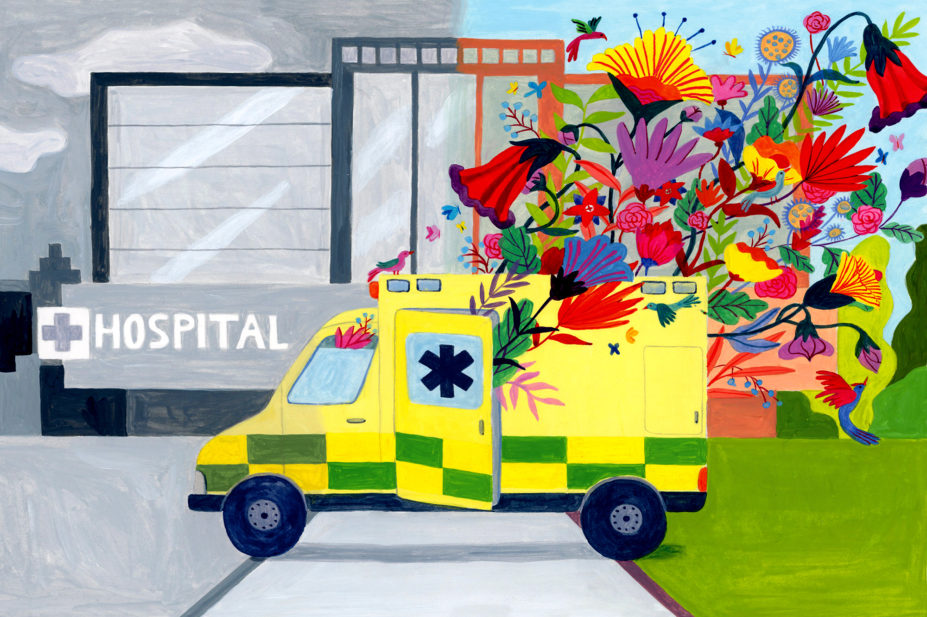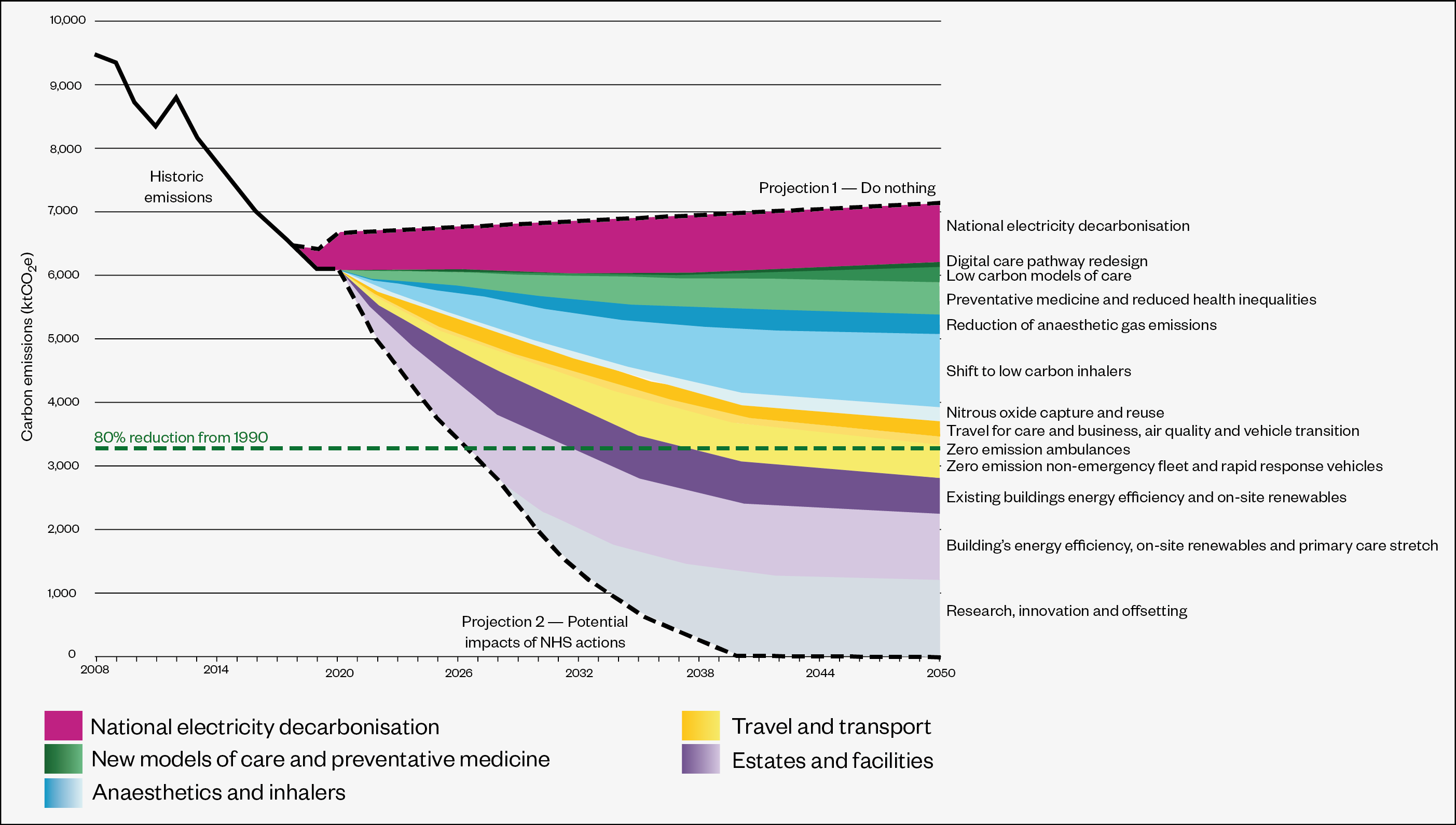
Iratxe López de Munáin
In October 2020, amid a global pandemic, the NHS set itself the enormous challenge of becoming the world’s first net zero national health service.
With more than 1.4 million staff across the UK, contributing around 4% of total carbon emissions and 7% of the economy in England, the NHS has both the capacity and responsibility to reduce its carbon footprint[1].
“We’re guilty… we fuel climate change,” says Richard Hixson, a critical care consultant and clinical lead for sustainability at County Durham and Darlington NHS Foundation Trust.
“The NHS and healthcare in general [contributes] roughly 5% of global emissions — that’s twice aviation and twice container shipping.”
And it is not just the planet that will benefit from reducing these emissions — the drivers of climate change also drive ill health and health inequalities. For example, research published in 2019 suggested that up to one third of new asthma cases in Europe could be avoided as a result of efforts to cut emissions[2].
“The more climate change progresses, the more people will be banging on our door with climate change-related illness,” says Hixson.
First do no harm is no longer the patient, it’s the planet
Richard Hixson, clinical lead for sustainability, County Durham and Darlington NHS Foundation Trust
“But we will also have interrupted supply chains, so we won’t get the pharmaceuticals, we won’t get the equipment, we won’t get the personnel in to provide healthcare, so healthcare will fail.
“First do no harm is no longer the patient, it’s the planet.”
To avoid this intimidating trajectory, the NHS is setting its sights understandably high (see Figure 1).
In England, the NHS is aiming first to become net zero by the year 2040 for emissions it controls directly, and then to reach net zero by 2045 for emissions it influences but does not directly control[3].
NHS Scotland is going one step further, bringing forward its target date for achieving net zero emissions from 2045 to 2040[4]. In Wales, the public sector is aiming for net zero carbon by 2030, with the NHS contributing a 34% reduction by the same deadline[5].
However, to achieve these ambitious targets, each area of the NHS needs to act.
Each trust and integrated care system (ICS) in England has been asked to produce a green plan, setting out its aims, objectives and delivery plans for carbon reduction while reflecting national priorities.
For trusts, the deadline for finalising and submitting green plans to ICSs was 14 January 2022. Following this, each ICS will develop a consolidated system-wide green plan by 31 March 2022, which will be peer reviewed regionally before being published[6].
It is evident from the 38 trust green plans seen by The Pharmaceutical Journal through a Freedom of Information (FOI) request that trusts vary in their initial approaches to the challenge; however, all are taking these targets seriously, with a small number setting their sight on achieving net zero by 2030 — in just eight years’ time.
But this is just the beginning, and for many it is a standing start.
“I am really pleased with the progress we’ve made,” says Hixson. “We’ve made that start, we will get there. But I can’t imagine the effort it’s going to take.”

Reproduced from NHS England’s ‘Delivering a ‘Net Zero’ National Health Service’ (2020)[1]

Leeds Teaching Hospitals NHS Trust’s green plan sets out an aspiration to become one of the greenest NHS trusts in the UK.
“We wanted a really clear ambition and that has been consistently articulated throughout,” explains Libby Sutherland, its sustainability manager.
Sustainability isn’t a ‘nice add-on’ to our core business, it’s instrumental in everything that we do
Libby Sutherland, sustainability manager, Leeds Teaching Hospitals NHS Trust
“Sustainability isn’t a ‘nice add-on’ to our core business, it’s instrumental in everything that we do.”
With several awards and award nominations already under its belt, the trust appears to be making significant strides towards that goal.
Sutherland says the trust is working “at absolute pace” to decarbonise its existing estate comprising five main hospital sites, each of which brings its own challenges in terms of improving efficiency and reducing carbon emissions.
“We all know what our net zero strategy looks like … now we need to drill down into the detail in terms of what that might look like for each of the hospital buildings,” says Sutherland.
As well as improving the existing buildings by implementing measures such as LED lighting, window glazing and solar power, the trust is also incorporating energy-saving design features into a new hospital at Leeds General Infirmary. This is being built as part of the NHS’ health infrastructure plan (HIP); a five-year programme of investment in health infrastructure described by prime minister Boris Johnson as the biggest hospital building programme “in a generation”[7].
“It’s all in the design features,” explains Sutherland. “The façade, the solar shading and all of the calculations that go into making sure that the building is as efficient as possible.”

As well as improving the efficiency of the physical buildings, the green plans show that trusts are thinking outside the four walls of the hospital.
According to University Hospitals Dorset NHS Foundation Trust’s green plan, it is teaming up with local wildlife organisations to influence air pollution in and around the hospital sites and improve biodiversity.
“We want to show leadership by minimising air pollution from activities within our control, which will hopefully help our local community to understand the relationship between air pollution and hospital admissions,” says Tracy Lyons, founder of Pharmacy Declare, a group of climate conscious pharmacy professionals based in the UK, and medicines optimisation pharmacist and pharmacy sustainability lead at Poole Hospital.
We want to show leadership by minimising air pollution from activities within our control
Tracy Lyons, founder of Pharmacy Declares and pharmacy sustainability lead at Poole Hospital
Meanwhile, County Durham and Darlington NHS Trust’s green plan goals include having locally produced fruit and vegetable stalls on hospital grounds, promoting meat-free days across hospital catering services, and communicating the health and carbon benefits of diets with fewer processed foods by 2024.
To do this, the trust will provide space on the grounds for the growth and cultivation of food, develop herb gardens and review all menus and catering contracts to ensure the use of local and healthy food where possible.
For Hixson, actions such as these are easy wins. “We’re very limited by procurement contracts by law, but with food we won’t have to be so constrained — it should be local, it should be seasonal — it reduces transportation and supports local communities.”
Overall, 63% of the green plans seen by The Pharmaceutical Journal highlight the importance of not only healthy, but also local, produce (see Figure 2).


Hospital trusts are also starting to embrace the increasing availability of electric vehicles (EVs). Half of the green plans seen by The Pharmaceutical Journal detail proposals for more EV charging points to be used by staff and patients alike, and nearly 30% of the plans contain details of an EV care lease scheme for staff.
In addition, some hospitals are hoping to trial the first zero emissions ambulances, as unveiled at the United Nations Climate Change Conference in Glasgow (COP26), held at the end of 2021[8]. This innovation, which is due to be rolled out throughout the NHS in England, is promising to reduce emissions by the equivalent of 730,000 car journeys from Cornwall to Glasgow each year.
NHS England says it is “still looking into and planning for” which sites will trial the ambulances.
People have a lot of barriers as to why they can’t get out of their car, but if they do it once they realise the bus isn’t that bad
Libby Sutherland, sustainability manager, Leeds Teaching Hospitals NHS Trust
Leeds Teaching Hospitals NHS Trust is also looking at reducing the local air quality impact associated with travel and transport to and from NHS sites by providing ultra-low emission shuttle buses and promoting a ‘one-day-a-week’ campaign.
“We’ve done quite a bit [of work] on encouraging staff not to use their car to come to site,” says Sutherland.
“People have a lot of barriers as to why they can’t get out of their car, but if they do it once they realise the bus isn’t that bad, they feel a lot better and then change their behaviour and tend to do it more than one day a week — it’s just getting them to make that transition.”

While there are some easy wins, many areas of the NHS’s green agenda will present significant challenges to trusts.
One of these — and an area that received significant attention during the COVID-19 pandemic — is personal protective equipment (PPE); much of which is single-use and predominately made from plastic[1].
However, just 13% of trust plans seen by The Pharmaceutical Journal mention the introduction of reusable PPE.
“PPE is an absolute challenge,” says Sutherland. “We’re progressing and looking at options around reusable PPE at the moment.”
Every single item of plastic apparel that we wear, we’ve got to question whether it’s necessary … plastic will kill the planet
Richard Hixson, clinical lead for sustainability, County Durham and Darlington NHS Foundation Trust
Hixson agrees that the infection control agenda has made it difficult to progress in certain areas.
“Every single item of plastic apparel that we wear in order to reduce infection — we’ve got to question whether that’s necessary, whether there is evidence to support it — plastic will kill the planet.”
However, for Sutherland there are other, much larger challenges to be surmounted in the future; for example, indirect emissions that occur in producing and transporting goods and services, including the full supply chain.
“There’s a lot of knowledge gathering that needs to be done, not just at a trust level but nationally in terms of the procurement of goods — unpacking the supply chain and working out, what are the true carbon emissions for the goods that we buy within the NHS?” she says.
“We purchase something that has been produced in a factory in Malaysia, and then it might go to another country to get packaged, then it gets imported. I don’t feel we have a good understanding of supply chain emissions” (see Box).
Box: Are green plans enough to get to net zero?
At the United Nations Climate Change Conference in Glasgow (COP26) in 2021, 50 countries committed to develop climate-resilient and low carbon health systems; 14 of which have set a target date to reach net zero carbon emissions on or before 2050.
Andrew Haines, a professor of environmental change and public health at the London School of Hygiene and Tropical Medicine, says with its ambitious targets the UK could be “a tremendous example” for the rest of the world.
However, he adds that target dates are always “a balance between ambition and what’s actually achievable”.
The biggest challenge in getting to net zero, Haines says will be “consumption-based” emissions.
“[Reducing those] depends on the action by third parties; the pharmaceutical industry, medical equipment industry and other suppliers,” he explains.
“There are practical issues there because they in turn probably have many, many suppliers” — more than 50,000, according to a senior employee of a pharmaceutical company that Haines spoke to.
“Even if we assume they have hundreds of suppliers, that is quite a challenge for the industry, to ensure that their suppliers are actually adhering to net zero emission targets. How do we actually monitor those consumption emissions?”
But, on the positive side, says Haines, the NHS net zero plan could have a “dramatic knock-on effect” across a whole range of different companies and sectors in the UK.
“I think it’s absolutely right to have very ambitious goals because, as we all know, we’ve got to move towards zero emissions very quickly over the coming decades.
“What’s important is we don’t just stop at the healthcare system. It has to be part of a broader initiative to get towards net zero emissions across all sectors.”

Although ambitious targets have already been set to reduce carbon emissions from anaesthetic gases and inhalers, for those at the heart of trust sustainability efforts, achieving a greener NHS means going beyond carbon emissions — particularly when it comes to medicines.
“If we just tackle carbon, we fail,” says Hixson. “We have to tackle carbon and the net zero agenda alongside a waste and pollution agenda, alongside a nature agenda.
“We can’t get bogged down by carbon. It’s one of many problems that we face within the climate change agenda.”
Hixson sees molecular pollution, whereby chemicals and plastics enter the rivers, streams and waterways, as more of a pressing threat than carbon emissions.
“We’ve seen more forever chemicals, toxic chemicals and plastics introduced in the ecosystem in the past 70 years and it’s been exponentially climbing. When oceanic biomass decreases, its photosynthetic capacity decreases and this is our biggest ally against climate change.
If we don’t focus on molecular pollution … what we’ll find is our net zero goal just constantly disappears over the horizon
Richard Hixson, clinical lead for sustainability, County Durham and Darlington NHS Foundation Trust
“If we don’t focus on molecular pollution … what we’ll find is our net zero goal just constantly disappears over the horizon — CO2 levels will just keep climbing even though our carbon input is falling.”
He adds that he still has colleagues in other hospitals who believe it is OK to put anaesthetic drugs down the sink, highlighting that there is still educational work to be done.
According to its consultation draft climate emergency and sustainability strategy for 2022–2026, NHS Scotland is already planning to work on testing ways to eliminate pharmaceutical residues from hospital wastewater, limit the growth of antimicrobial resistant bacteria and prevent harm to biodiversity[4].
Its consultation says that an estimated 30–90% of all oral medicines may result in active substances being excreted through urine into wastewater systems.
Lyons agrees that, despite greener NHS targets starting with a focus on decarbonisation, it is important not to “lose sight” of the other environmental impacts of drug use.
In October 2021, the Royal Pharmaceutical Society launched its sustainability policy in which it said that the environmental risk of medicines should be readily available from manufacturers to allow it to be included in NHS prescribing guidance and formularies.
This is something that already exists in some Nordic countries, Lyons explains.
“In the meantime, UHD has developed medicines disposal guidance so that all drugs are disposed of in the correct way to limit environmental exposure… Everything that reduces the need for, and optimises use of, medications limits pollution too.”

While the COVID-19 pandemic has made it difficult to keep sustainability on the agenda, Hixson says it has demonstrated how it is possible to drive change on a population level.
He says getting everyone on board, rather than relying on the enthusiasm of a small number of individuals, is essential for success when it comes to tackling climate change.
“What we find with the sustainability agenda is you tend to have a core group of real enthusiasts,” says Hixson. “But the power in the NHS is not that core group — it is the 1.4 million people who comprise the NHS and the million people they touch with their clinical activities every 36 hours.”
To capitalise on this, County Durham and Darlington NHS Trust has developed a network of ‘green champions’ to facilitate communication and actions to the wider workforce.
“We have an amazingly large group of people who can be educated and who can also become educators — you’ve got to have people who are networked, who understand and who can become those evangelical people ‘on the shop floor’ in every department,” explains Hixson.
“The role of green champions is not necessarily to do the work, but it’s to become the voice to make sure that these messages are properly communicated.”
However, he highlights that more central investment is still needed to truly make a difference and encourage more people to take on the responsibility that he has, largely voluntarily.
“There’s a little bit of a trickle down of money, but it doesn’t even fund two days a week of clinical sustainability work. If we want this agenda to be delivered, it’s going to take a heck of a lot of funding.”
- 1Delivering a ‘Net Zero’ National Health Service. NHS England. 2020.https://www.england.nhs.uk/greenernhs/wp-content/uploads/sites/51/2020/10/delivering-a-net-zero-national-health-service.pdf (accessed 23 Feb 2022).
- 2Khreis H, Cirach M, Mueller N, et al. Outdoor air pollution and the burden of childhood asthma across Europe. Eur Respir J. 2019;54:1802194. doi:10.1183/13993003.02194-2018
- 3UK health services make landmark pledge to achieve net zero. GOV.UK. 2021.https://www.gov.uk/government/news/uk-health-services-make-landmark-pledge-to-achieve-net-zero (accessed 23 Feb 2022).
- 4NHS Scotland climate emergency and sustainability strategy 2022 to 2026 – draft: consultation. Scottish Government. 2021.https://www.gov.scot/publications/nhs-scotland-draft-climate-emergency-sustainability-strategy/ (accessed 23 Feb 2022).
- 5NHS Wales Decarbonisation Strategic Delivery Plan. Welsh Government. 2021.https://gov.wales/sites/default/files/publications/2021-03/nhs-wales-decarbonisation-strategic-delivery-plan.pdf (accessed 23 Feb 2022).
- 6How to produce a Green Plan: A three-year strategy towards net zero. NHS England . 2021.https://www.england.nhs.uk/greenernhs/wp-content/uploads/sites/51/2021/06/B0507-how-to-produce-a-green-plan-three-year-strategy-towards-net-zero-june-2021.pdf (accessed 23 Feb 2022).
- 7Health infrastructure plan. GOV.UK. 2019.https://assets.publishing.service.gov.uk/government/uploads/system/uploads/attachment_data/file/835657/health-infrastructure-plan.pdf (accessed 23 Feb 2022).
- 8Blog: Zero emission ambulances show the NHS is in the driving seat in the race to net zero. NHS England. 2021.https://www.england.nhs.uk/greenernhs/2021/10/zero-emission-ambulances-show-the-nhs-is-in-the-driving-seat-in-the-race-to-net-zero/#:~:text=The%20NHS%20has%20today%20unveiled,tackling%20climate%20change%20at%20source (accessed 23 Feb 2022).


